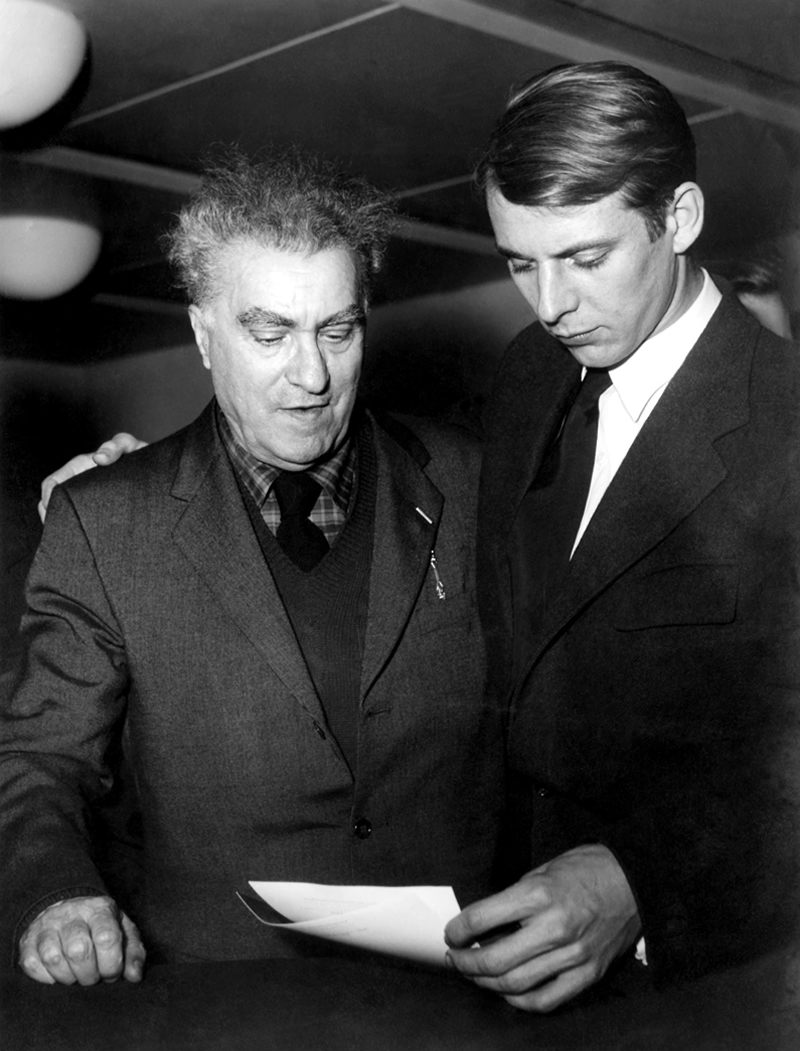
Instrumentation Works for Orchestra
Stockhausen Complete Edition on CD
Since 1991, a complete edition of all recordings in which Karlheinz Stockhausen has personally participated is being released on compact discs. Each CD in this series is identified by Stockhausen's signature followed by an encircled number. The numbers indicate the general historical order of the works.
Stockhausen realised the electronic music and participated in these recordings as conductor, performer, sound projectionist, and musical director. He personally mixed down the recordings, mastered them for CDs, wrote the texts and drew the covers.
- The compact discs may be obtained from the Stockhausen-Verlag: Kettenberg 15, 51515 Kuerten, Germany (www.stockhausenCDs.com).
Karlheinz Stockhausen
Instrumentation Works for Orchestra
MOMENTE / MOMENTS
Origin – First performances – Recordings
for solo soprano, 4 choir groups and 13 instrumentalists
(Duration circa 113 minutes)
INSTRUMENTS
During the first week of January 1962 in Siculiana, Sicily, I made the fundamental sketches of MOMENTE for solo soprano, 4 choir groups, 4 trumpets, 4 trombones, 2 electric organs and percussion (3 players).
30 Moments and 71 Inserts may be joined into various versions.
By April 1962, I had composed a first group of Moments, commissioned by
the West German Radio, which lasted circa 25 minutes. Its world première
was conducted by me on May 21st 1962 at the Cologne radio station, with
Martina Arroyo as solo soprano, the choir and instrumentalists of the West
German Radio, Aloys and Alfons Kontarsky (Hammond and Lowrey
organs).
After that, I worked out another group of Moments which had been
planned in 1962, and conducted the Donaueschingen Version (duration circa
61 minutes) – likewise with Martina Arroyo and the WDR ensemble – on
October 16th 1965 during the Donaueschingen Music Days.
In 1963 I rehearsed a Palermo Version, but it failed because of the choir,
and I conducted a Buffalo Version in 1964 with Martina Arroyo (soprano)
and a student ensemble of the University of Potsdam near Buffalo, New
York. The student choir sang from memory.
By 1969, the composition of all the Moments had been completed. For the
world première of all Moments, I made a new version with a duration of 113
minutes. It was performed under my direction on December 8th 1972 in
Bonn at the Beethoven Hall with Gloria Davy (soprano), the choir of the
West German Radio, the instrumental ensemble Musique Vivante (Paris),
Roger Smalley (large Hammond organ), and Harald Bojé (Lowrey organ).
This was followed by a European tour, which is why this version is
designated as the Europe Version. We then made a recording for Deutsche
Grammophon, which is now released by the Stockhausen-Verlag as double
CD 7 A–B in the Stockhausen Complete Edition.
In 1998, Rupert Huber conducted a slightly altered version at the Philharmonic Hall in Cologne and on a tour which followed, with Angela Tunstall (solo soprano), the choir of the West German Radio, the instrumental ensemble musikFabrik, and two synthesizer players Massimiliano Viel and Antonio Pérez Abellán, with me as sound projectionist. This recording, in which I did not participate, however, has also been released in the Stockhausen Complete Edition on CD 80 A-B.
Texts
In each performance, four languages occur: the German texts should be sung in the vernacular of the performing ensemble, and some parts – specified in the score – are sung in a first, second and third foreign language.
| 1. | The Song of Solomon. (The German is taken from the Luther translation of the Old Testament, the English is a translation of the German texts.) |
| 2. | Excerpts of a letter from Mary Bauermeister. |
| 3. | Several exclamations from the Trobriand Islands in British New Guinea (from The Sexual Life of Savages in Northwestern Melanesia by Bronislaw Malinowski. New York: Harcourt, Brace & World, Inc., 1929). |
| 4. | A quote from William Blake:"He who kisses the joy as it flies lives in Eternity's sunrise."
found in the "Prelude" of the book, Man's Emerging Mind by N.J.
Berill, New York: Fawcett World Library, 1955. |
| 5. | Names from fairy tales, self-formed names, calls. |
| 6. | Audience reactions (shouts, phrases). |
| 7. | Self-formed onomatopoetic words and purely phonetic nonsense syllables. |
All texts without source indication are by the composer.
Scoring
4 mixed choir groups (4 x 16 voices; in smaller halls perhaps 4 x 12 voices*):
| CHOIR I | 4 sopranos | The choir is seated in 4 rows of 4 singers |
| 4 altos | each, one behind the other at the left: | |
| 4 tenors | 4B 4T 4A 4S | |
| 4 basses. | • • • • | |
• • • • facing  |
||
| • • • • | ||
| • • • • |
 ):
):There should be trays attached to the music stands for laying down the supplementary instruments.
| CHOIR II | 4 sopranos | The choir is seated in 4 rows of 4 singers |
| 4 altos | each, one behind the other at the half-left: | |
| 4 tenors | 4B • • • • | |
| 4 basses. | 4T • • • • facing |
|
4A • • • • |
||
4S • • • •
 |
 ):
):| CHOIR III | 4 sopranos | The choir is seated in 4 rows of 4 singers |
| 4 altos | each, one behind the other at the half-right: | |
| 4 tenors | 4B • • • • |
|
| 4 basses. | facing 4T • • • • |
|
4A • • • • |
||
 4S • • • • 4S • • • • |
 ):
): = shake once briefly,
= shake once briefly,  = continually shake or turn in the hand.
= continually shake or turn in the hand.There should be trays attached to the music stands for laying down the supplementary instruments.
| CHOIR IV | 4 sopranos | The choir is seated in 4 rows of 4 singers |
| 4 altos | each, one behind the other at the right: | |
| 4 tenors | 4S 4A 4T 4B |
|
| 4 basses. | • • • • |
|
 facing • • • • facing • • • • |
||
• • • • |
||
• • • • |
 ):
):There should be trays attached to the music stands for laying down the supplementary instruments.
See photographs of the supplementary instruments below.
Choir soloists
3 men choir soloists, one choir soprano and one choir alto also sing solo passages: 1 tenor in choir II, 1 baritone in choir II, 1 bass in choir III or IV, one soprano in choir II, 1 alto in choir IV. In addition, there are some very short solo parts which the conductor assigns.
Each of the 3 men soloists, the choir soprano and the choir alto have a highly
directional microphone which can be inaudibly switched on and off. It is
also possible to use transmitters.
The 5 microphones (or transmitters) are circuited to amplifiers, the
volume of which can be regulated either by the conductor (using 5 faders
attached to the conductor’s music stand) or by a sound projectionist in the
middle of the hall.
Stimmhaftes Flüstern (voiced whispering) should be clearly audible, even
when all the others are singing .
.
The loudspeakers stand at the far left, middle and far right (see seating plan on page VIII).
In the Moments in which the 3 men soloists do not have special parts to
sing, they should sing with the choir, as notated in their parts.
Commentary about the choir
The part of the solo choir soprano is written in the parts of all four choirs, with "evtl. 1 Chorsopran / perhaps 1 choir soprano" (preferably by a soprano in choir II).
In some places the indication "für evtl. 4. Sänger (perhaps for the 4th singer)" is written in every choir part. This does not apply when there are only 4 x 3 voices per choir. In a few places the distribution of the three singers must then be changed.
When there are only 3 singers per voice and the notation is two-part (occasionally as "divisi"), only 1 singer of the 3 should sing the upper part and 2 singers should sing the lower one.
The choir soloists sometimes have tacet sections, in which they could sing
normally with the choir. This has been done deliberately, however, either to
avoid potential microphone problems, or because they should remain "in
their role", for example in the  (k) Moment.
(k) Moment.
After the choir soloists have been chosen (for example the 2 men soloists in choir II), one singer may be lacking in the respective bass group. The conductor then decides on the distribution.
Instruments
4 trumpets in C
Each trumpeter has 3 mutes:
1) S straight mute, 2) C cup mute,
3) W wawa mute:
 = almost closed with the hand,
= almost closed with the hand,  = hole of the mute open,
= hole of the mute open,
 = gradually close,
= gradually close,  = gradually open.
= gradually open.
 = remove mute. O = open (without mute).
= remove mute. O = open (without mute).
Each trombonist has 3 mutes:
1) S straight mute, 2) C cup mute, 3) W wawa mute:
For places where manipulating the mute is too difficult (closing and opening the hole of the mute with the hand), each trombonist should have a stand on which a metal or cardboard "hat" is mounted. Then he holds the bell of his instrument in or in front of this hat:
 = almost closed with the hand (or in the hat),
= almost closed with the hand (or in the hat),
 = hole of the mute open (or next to the hat),
= hole of the mute open (or next to the hat),
 = gradually close,
= gradually close,  = gradually open.
= gradually open.
 = remove mute. O = open (without mute).
= remove mute. O = open (without mute).
Trombonists 1 and 3 sometimes use a plunger instead of a mute.
For the bass trombones, large-sized mutes and large hats must be acquired do not use French horn mutes). By no means should the mutes be omitted or replaced by the wrong kind.
Mute indications in the Inserts may be changed, if necessary.
2 electric organs
From 1962–1972, 2 electric organs were used: 1 large Hammond organ
(with a range of 5 octaves), 1 smaller Hammond organ or 1 Lowrey organ.
Both had sliding bars (draw bars) for gradually changing the registers, pedal
swells, vibrato which could be gradually changed, and quite a large resonance
box with loudspeaker (Leslie).
In 1998, synthesizers with similar timbres were used instead of the organs
(the recording of MOMENTE on CD 80 of the Stockhausen Complete
Edition should be studied in this regard). However, it is not recommended to
replace the organs by synthesizers any more.
For each organ, an amplifier and a loudspeaker is needed in addition to
the monitor loudspeaker, depending on the size of the hall. The volume of
the additional loudspeakers should be regulated either by the players or by
the sound projectionist in the middle of the hall.
At some places the organists also play percussion instruments:
| Keyboard player I | 5 cinelli (like percussionist I ): small thick cymbals (diameter ca. 27–15 cm) on a special stand consisting of an iron arc onto which 5 metal pins with rubber holders have been welded. View from the front: The stands should be adjustable in height and high enough so that it is possible to strike the cinelli from above. The 5 pitches should be approximately equidistant from each other: |
 ; notation: ; notation:  |
| Keyboard player II | 1 sizzle cymbal on stand: a large cymbal (ca. 70 cm in diameter), the entire surface of which has been drilled full of holes. In these holes there are metal rivets which rattle when the cymbal is struck. (The metal rivets hang loosely in the holes.) Normal stand. 4 cymbals of various sizes on stands (for instance diameters of 72 cm - 63 cm - 56 cm - 51 cm). |
Both keyboard players need  = 2 hard beaters,
= 2 hard beaters,  = 2 soft beaters.
= 2 soft beaters.
Explanation about the organs in the  (d) Moment
(d) Moment
The average intensity slowly and continuously oscillates around the threshold
of audibility (sometimes becoming inaudible). Now and then short  .
.
From time to time briefly switch on fast vibrato (if possible, gradually; if
not possible, turn down volume completely before switching on vibrato or
begin the vibrato with a slight accent, and then after a quick diminuendo,
switch it off
again:  ).
).
A graphic scheme is drawn above the staves for the overtone registration. Tendency: gradual change from the brightest to full registration, then to the darkest, back to full and to the brightest registration. Interrupt this timbre band briefly, expand or supplement it (the scheme serves only as an example). If a 2nd Hammond organ (having sliding bars for gradually changing registration) is not available, then before switching between fixed registrations, the volume should be lowered completely, then the timbre switched and the volume gradually raised again.
Only the left hand takes the clusters and very gradually "crawls" key-bykey
downwards and upwards again. During this, the right hand can toss in
extremely soft short timbre interjections on the upper manual, approximately
as often as indicated in the graphic scheme: "wiper" clusters greatly
varying in width, more or less glissandoed, sometimes  or
or
 or
or  with the swells; pitch-wise within the register of the
band which is being held each time by the left hand. Use reverberation.
with the swells; pitch-wise within the register of the
band which is being held each time by the left hand. Use reverberation.
The two players are independent of each other.
3 percussionists
Percussionist I (at the left)
There are several places where either percussionist I or keyboard player I plays 5 small cymbals (cinelli). In each case, the players decide between themselves who will play the passage.
 = DERI glissando drum (see photo at the lower right).
= DERI glissando drum (see photo at the lower right).
 = oval snare drum with snares (very bright).
= oval snare drum with snares (very bright).
 = 5 small cymbals (cinelli), on a curved iron stand,
= 5 small cymbals (cinelli), on a curved iron stand,
 |
equidistantly pitched between  (  manufactured by PAISTE) manufactured by PAISTE) ca. 27–15 cm, hard beaters. ca. 27–15 cm, hard beaters. |
 = 1 tambourine with jingles.
= 1 tambourine with jingles. = 1 tam-tam with a diameter of ca. 85 cm
= 1 tam-tam with a diameter of ca. 85 cm2 metal tubes like choir IV.
Percussionist II (at the right)
There are several places where either percussionist II or keyboard player II plays 4 cymbals and one sizzle cymbal. In each case, the players decide between themselves who will play the passage.
 = vibraphone.
= vibraphone.
 = 3 tom-toms (middle, low, very low),
= 3 tom-toms (middle, low, very low), (k):
(k):  .
. |
 = 4 cymbals on stands
(ca. 72 - 63 - 56 - 51 cm in diameter). = 4 cymbals on stands
(ca. 72 - 63 - 56 - 51 cm in diameter).1 sizzle cymbal: large bright cymbal which is full of holes in which rivets loosely hang. These rattle for a long time when the cymbal is struck (for example manufactured by PAISTE). |
1 pair of claves like choir II.
 = 1 tambourine with jingles;
= 1 tambourine with jingles;2 metal tubes like choir IV.
Percussionist III (middle), at the back of the stage
 = large tam-tam, diameter 160 cm (PAISTE): struck with
= large tam-tam, diameter 160 cm (PAISTE): struck with = 1 tambourine with jingles.
= 1 tambourine with jingles.2 metal tubes like choir IV.
 = 1 guero on a stand.
= 1 guero on a stand. = hard beater,
= hard beater,  = soft beater.
= soft beater.Always mute percussion instruments when a rest is notated.
Kinds of strokes for the  glissando drum and
glissando drum and  tom-toms,
tom-toms,
for example in  (d) and KM:
(d) and KM:
 = hit the head with stick.
= hit the head with stick. = tremolo on the head.
= tremolo on the head. = rub stick on the head.
= rub stick on the head. = rim-shot.
= rim-shot. = hit the rim of the drum with stick.
= hit the rim of the drum with stick. = stick on the rim with various distances between hand
= stick on the rim with various distances between hand = press the tip of one stick onto the head and hit the stick with the
= press the tip of one stick onto the head and hit the stick with the = increase distance between the hand and the place hit.
= increase distance between the hand and the place hit. = decrease the distance.
= decrease the distance. = hit head and stick on stick simultaneously.
= hit head and stick on stick simultaneously. = roll from the rim to the middle.
= roll from the rim to the middle. = holding tip of 1 stick on the head (for example, with the
left hand), make a rapid tremolo above and below that
stick with 2 sticks held in the other hand (for example,
right hand) – i.e. 3 sticks are used.
= holding tip of 1 stick on the head (for example, with the
left hand), make a rapid tremolo above and below that
stick with 2 sticks held in the other hand (for example,
right hand) – i.e. 3 sticks are used. etc. = write on the head with rough wood (broken-off end of
etc. = write on the head with rough wood (broken-off end of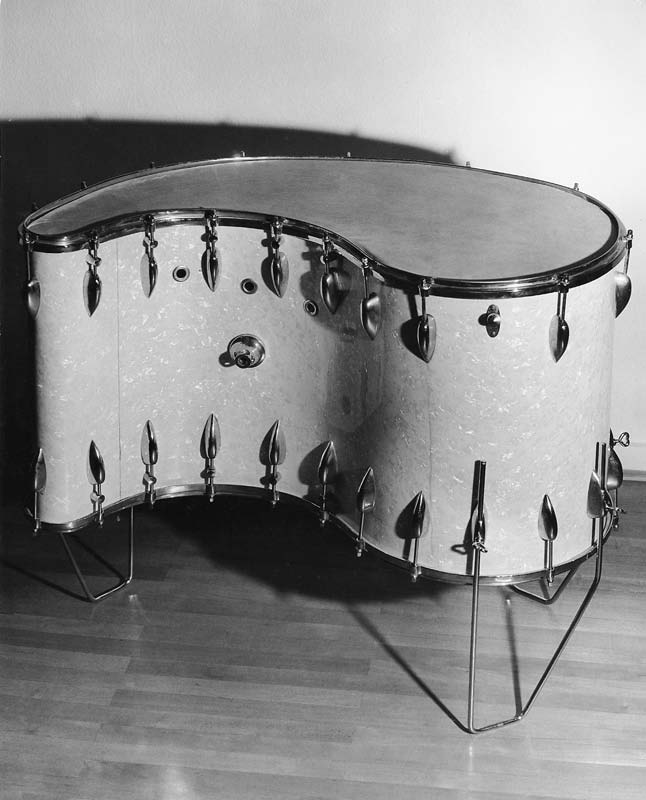
Percussionist I
Deri kidney drum for MOMENTE with calfskin head (not plastic), on which all pitches within a range of 1½ octaves can be produced.
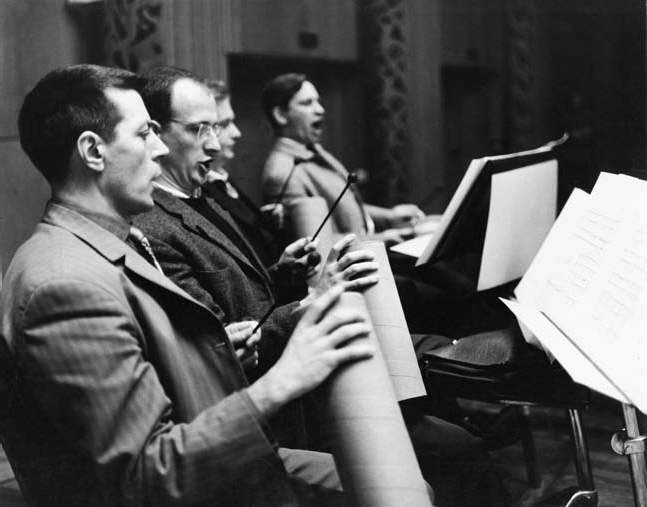
Bass group of choir I (MOMENTE rehearsals at the WDR on May 20th 1962).
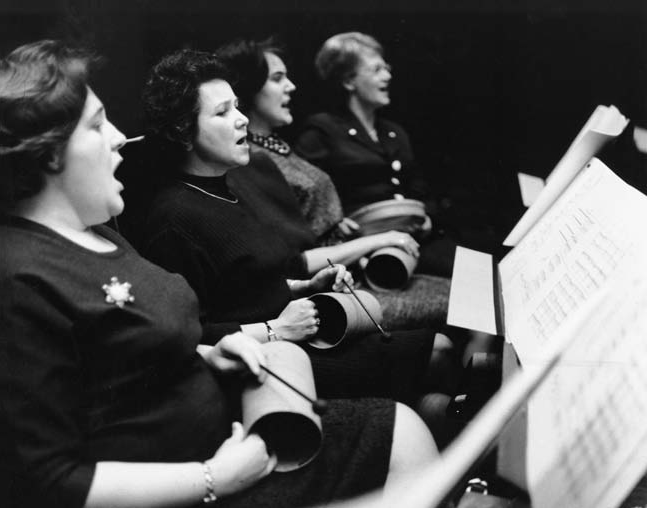
Soprano group of choir I (MOMENTE rehearsals at the WDR on May 20th 1962).
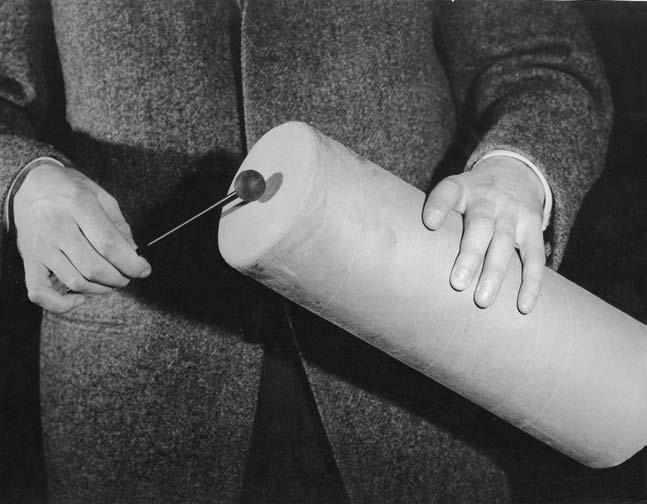
Choir I has 12 (or 8) tuned cardboard tubes with glued-on lids and 4 tambourines (played with a rubber-headed beater or sometimes with the hand).
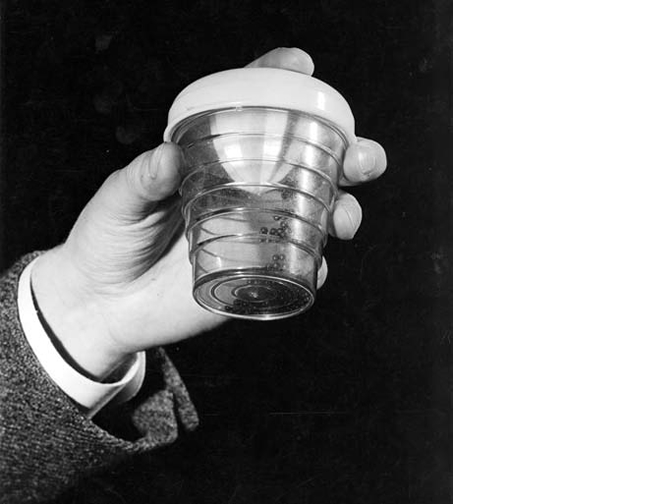
Choir III has 16 (or 12) "shot-boxes" (plastic containers, soa p boxes etc., con taining a small amount of buckshot); these are jolted, continuously shaken, or turned like maracas.
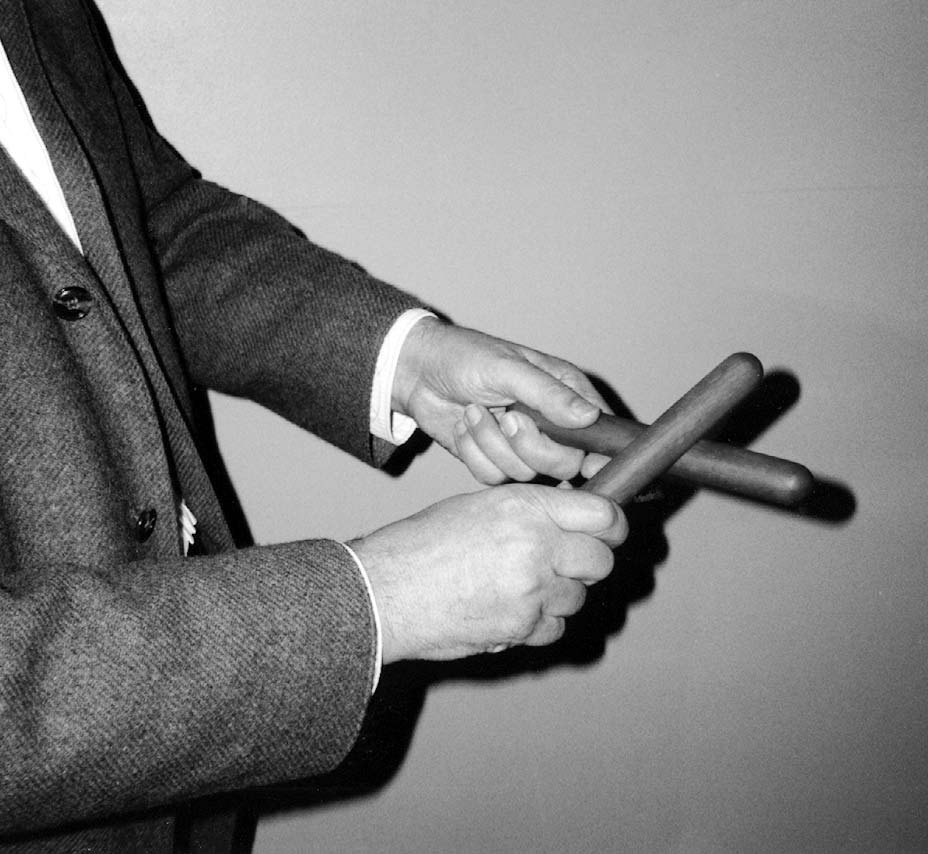
Choir II has 16 (or 12) pairs of variously-pitched claves (cylindrical pieces of hard wood) that are hit against each other or tremoloed.
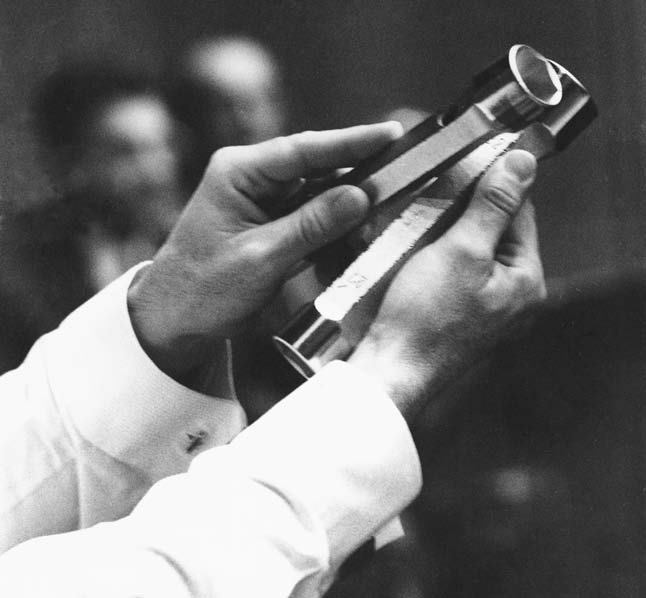
Choir IV has 16 (or 12) pairs of variously-pitched metal tubes (car spanners) that are struck against each other or continuously tremoloed.
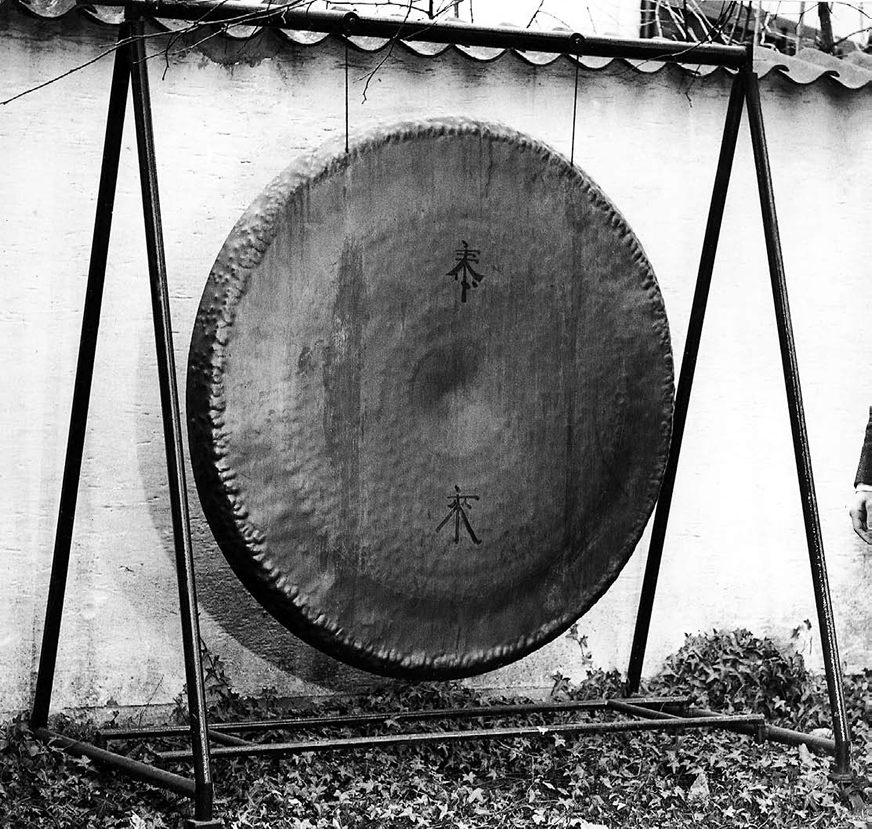
Percussionist III
The large tam-tam for
MOMENTE (manufactured
by PAISTE).
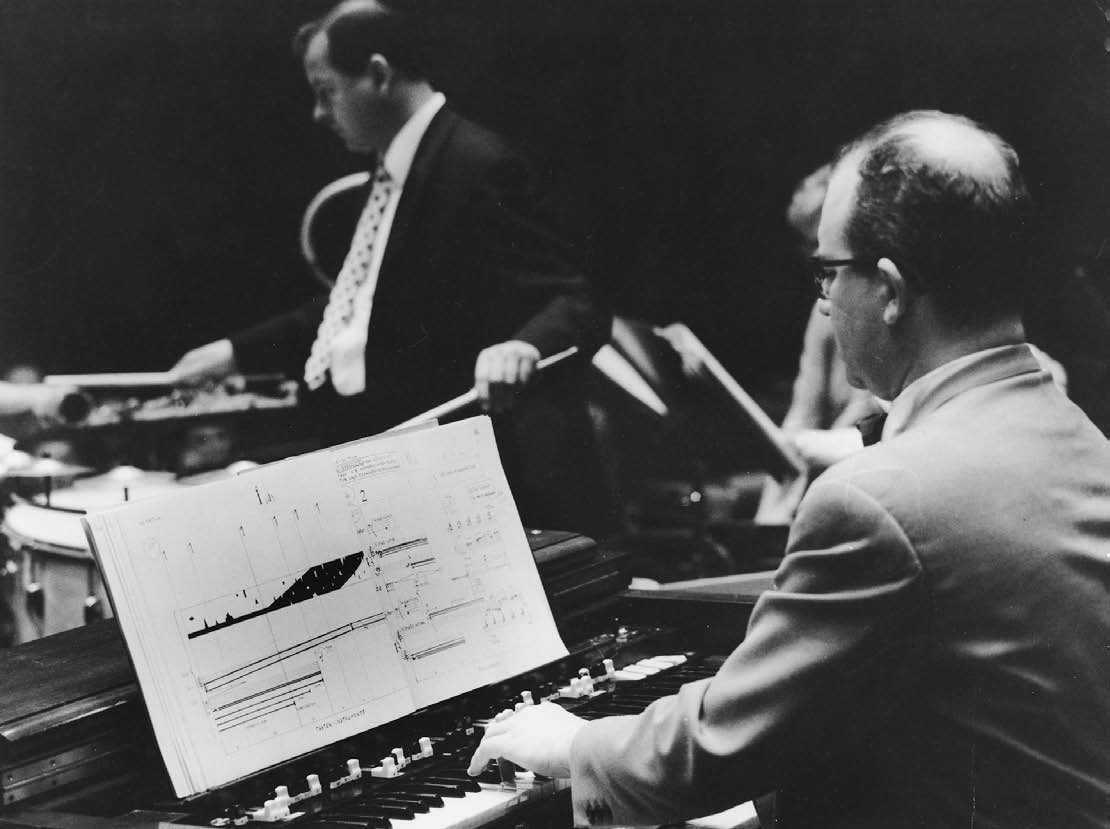
MOMENTE rehearsal at the WDR Cologne in October 1965: Aloys Kontarsky (Hammond organ).
Seating plan for the solo soprano, 4 choir groups and instruments (This seating plan is drawn for 12 instead of 16 singers per choir.)
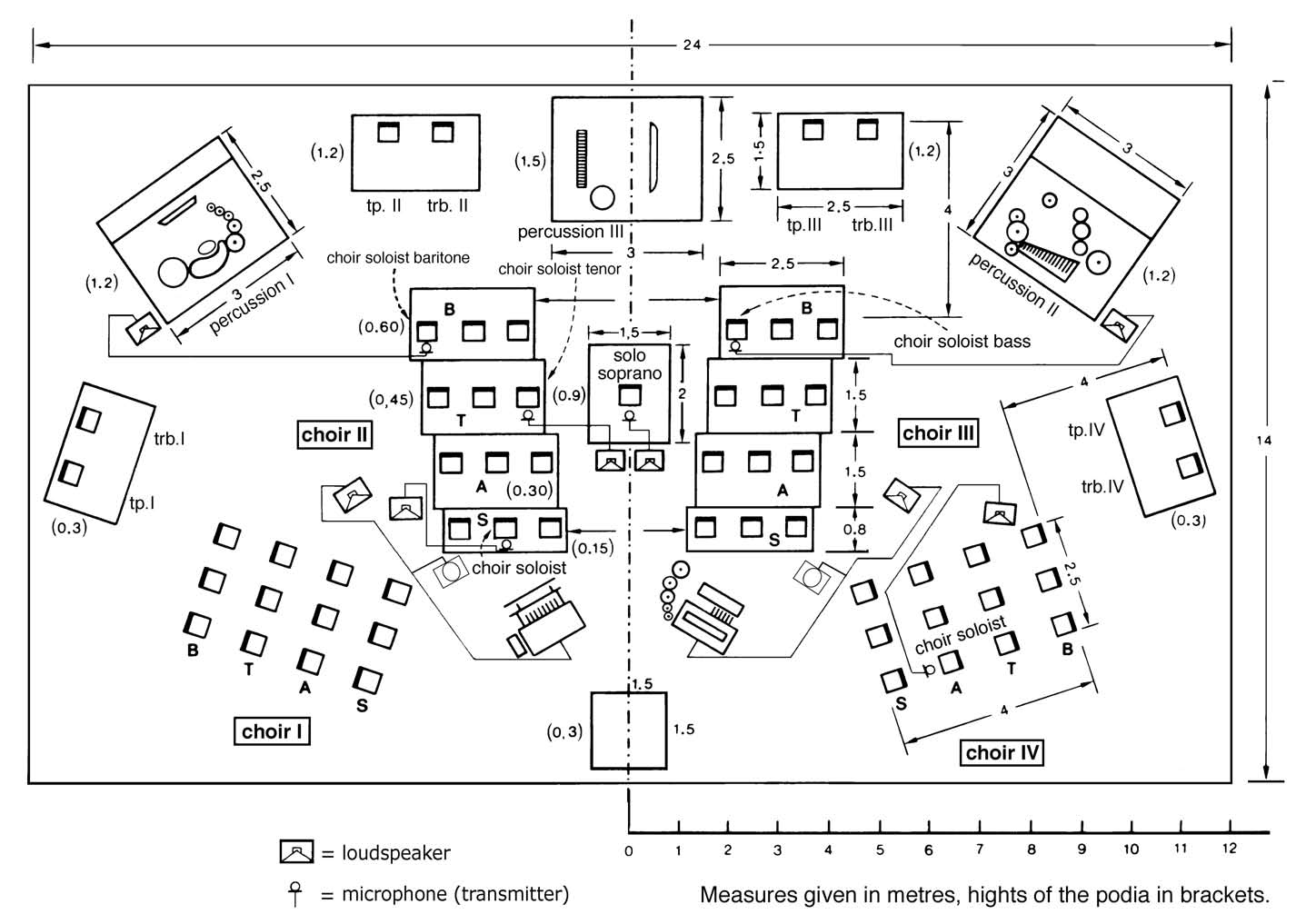
Special podia have to be built for the following set-up.
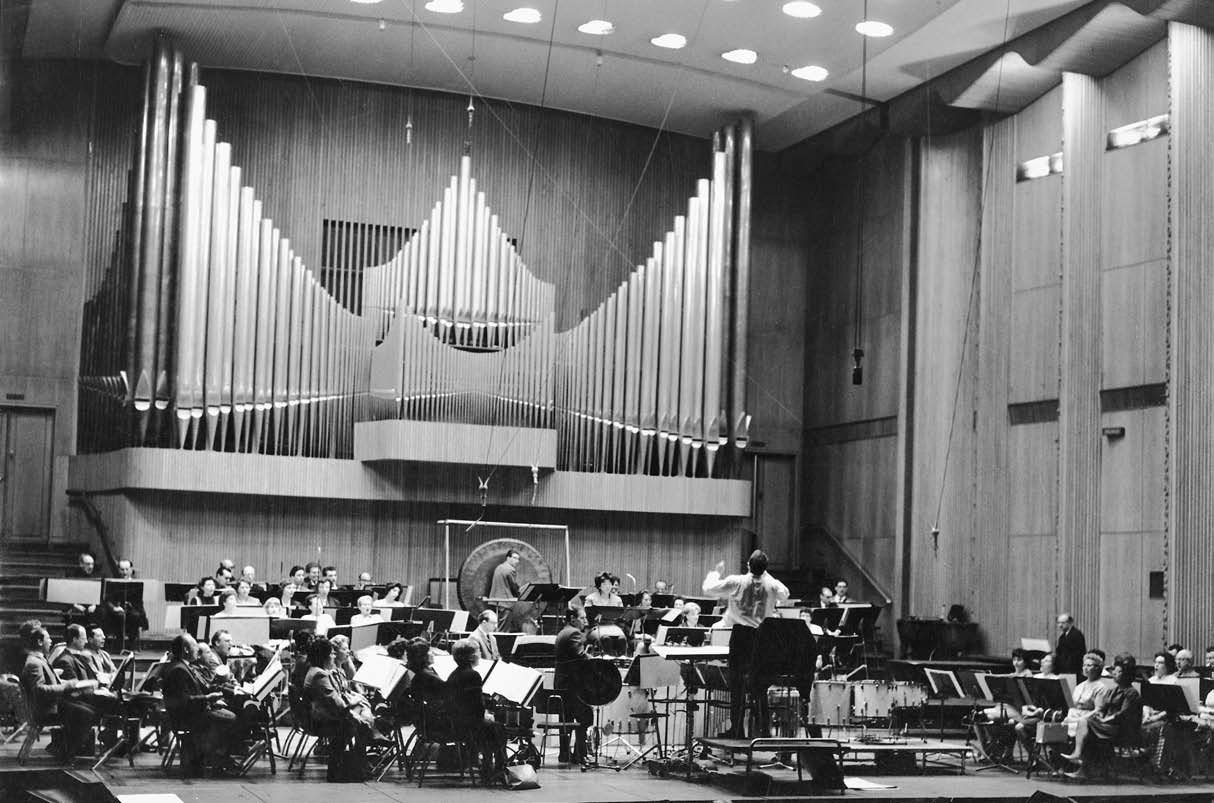
Dress rehearsal of MOMENTE at the large broadcast auditorium of the West German Radio in Cologne on May 21st 1962. The soloist was Martina Arroyo.